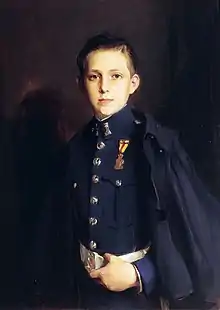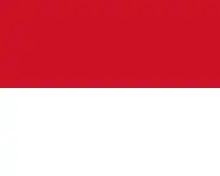| Infante Juan | |||||
|---|---|---|---|---|---|
| Count of Barcelona | |||||
 Don Juan in 1946 | |||||
| Head of the Royal House of Spain | |||||
| Tenure | 15 January 1941 – 14 May 1977 | ||||
| Predecessor | Alfonso XIII | ||||
| Successor | Juan Carlos I | ||||
| Born | 20 June 1913 Royal Palace of La Granja de San Ildefonso, San Ildefonso, Kingdom of Spain | ||||
| Died | 1 April 1993 (aged 79) Navarra University Hospital, Pamplona, Kingdom of Spain | ||||
| Burial | 7 April 1993 El Escorial, Community of Madrid, Spain | ||||
| Spouse | |||||
| Issue | |||||
| |||||
| House | Bourbon | ||||
| Father | Alfonso XIII of Spain | ||||
| Mother | Victoria Eugenie of Battenberg | ||||
| Religion | Roman Catholic | ||||
| Signature |  | ||||
| Military career | |||||
| Allegiance | Spain | ||||
| Service/ | Spanish Navy | ||||
| Rank | Captain general | ||||
Infante Juan, Count of Barcelona (Juan Carlos Teresa Silverio Alfonso de Borbón y Battenberg; 20 June 1913 – 1 April 1993), also known as Don Juan, was a claimant to the Spanish throne as Juan III.[2] He was the third son and designated heir of King Alfonso XIII of Spain and Queen Victoria Eugenie of Battenberg. His father was replaced by the Second Spanish Republic in 1931. Juan's son Juan Carlos I became king when Spain's constitutional monarchy was restored in 1975.
Early life
Juan was born at the Palace of San Ildefonso. His father was forced into exile when the Second Spanish Republic was proclaimed on 14 April 1931. Owing to the renunciations in 1933 of his brothers Alfonso, Prince of Asturias, and Infante Jaime, Duke of Segovia, Infante Juan became first in line to the defunct Spanish throne. He thus received the title Prince of Asturias when he was serving with the Royal Navy in Bombay.
In March 1935, he was appointed honorary sub-lieutenant[3] and passed his naval exams in gunnery and navigation, which would have entitled him to a lieutenant’s commission in the Royal Navy if he gave up his Spanish nationality. This, however, he refused to do.
Marriage
He met his future wife at a party hosted by Victor Emmanuel III of Italy on the day before his sister (Infanta Beatriz) was to be married. He married Princess María de las Mercedes of Bourbon-Two Sicilies (1910–2000), known in Spain as Doña María de las Mercedes de Borbón Dos-Sicilias y Orleans, in Rome on 12 October 1935.
Just before the birth of the Infante Juan Carlos, the Count of Barcelona decided to go hunting, with the doctor telling him and his wife that the future king would not be born for weeks. When he was told of the birth, he drove to the hospital so quickly that he broke an axle spring.
Children
They had four children:
- Infanta Pilar, Duchess of Badajoz (30 July 1936 – 8 January 2020), who married Luis Gomez-Acebo y de Estrada, Viscount de la Torre, on 6 May 1967, and had five children
- Juan Carlos I of Spain (born 5 January 1938), who married Princess Sophia of Greece and Denmark on 14 May 1962, and had three children
- Infanta Margarita, Duchess of Soria and Duchess of Hernani (born 6 March 1939), who married Don Carlos Zurita y Delgado on 12 October 1972, and had two children
- Infante Alfonso of Spain (3 October 1941 – 29 March 1956)
They lived in Cannes and Rome, and, with the outbreak of World War II, they moved to Lausanne to live with his mother, Victoria Eugenie. Afterwards, they resided at Estoril, on the Portuguese Riviera.
Claim to the Spanish throne

In 1931, Juan was subject to dynastic negotiations between the Alfonsists and the Carlists, concluded in so-called Pact of Territet; it has never been implemented. Juan became heir apparent to the defunct Spanish throne after the renunciations of his two older brothers, Alfonso and Jaime, in 1933. To assert his claim to the throne, following his father's death (in 1941) he used the title of Count of Barcelona, a sovereign title associated with the Spanish crown.
In 1936, his father sent him to participate in the Spanish Civil War but he was arrested near the French border, and sent back by General Emilio Mola.
On 19 March 1945, he announced a manifesto in Lausanne, demanding he replace Francisco Franco:
Today, six years after the Civil War, the regime established by General Franco, inspired from the start by the totalitarian systems and the Axis powers, so contrary to the character and tradition of our people, is fundamentally incompatible with the circumstances, which the present war is creating in the world. The foreign policy followed by the regime is compromising the future of the nation. Spain runs the risk of being dragged into a new fratricidal conflict and of finding itself totally isolated from the world. The present regime, however hard it tries to adapt to the new situation, is responsible for this double danger. Moreover, a new republic, however moderate in its beginnings and its intentions, will not be long in shifting to one of the extremes, thus strengthening the other and finishing up in a new civil war. Only the traditional monarchy can be an instrument of peace and concord to reconcile Spaniards; it alone can obtain respect from abroad, by means of an effective state of law, and realize a harmonious synthesis of that order and freedom upon which is based the Christian concept of the state. Millions of Spaniards of the most varied ideologies are convinced of this truth and see in the monarchy the only saving institution.[4]
When General Franco declared Spain a monarchy in 1947, he characterized it as a "restoration". However, Franco was afraid that Juan would roll back the Spanish State because he favoured constitutional monarchy, which would restore parliamentary democracy. As a result, in 1969, Franco passed over Juan in favour of Juan's son, Juan Carlos, who Franco believed would be more likely to continue the dictatorship after his death. Juan Carlos later surprised many by his support of democratising Spain. Franco and Juan did not have a good relationship, with the latter constantly pressing Franco to restore the monarchy. Relations soured further when Juan called Franco an "illegitimate usurper".
Juan formally renounced his rights to the Spanish throne eight years after being displaced as recognised heir to the throne by Franco, and two years after his son, Juan Carlos, had become king. In return, his son officially granted him the title of Count of Barcelona, which he had claimed for so long.
After his death in 1993, he was buried with honours due a king, under the name Juan III (his title if he had become king) in the Royal Crypt of the monastery of San Lorenzo de El Escorial, near Madrid.[2] His wife survived him by seven years.
He was fond of the sea, and joined the Naval School at San Fernando, Cádiz, and had tattoos of a marine theme from his time in the British Royal Navy.
Honours and arms
Honours
.svg.png.webp) Spain:
Spain:
- Knight of the Golden Fleece, 16 May 1927[5]
- Grand Cross of Naval Merit, with White Decoration, 17 July 1978[6]
- Grand Cross of Military Merit, with White Decoration, 5 February 1993[7]
- Grand Cross of Aeronautical Merit, with White Decoration, 5 February 1993[7]
.svg.png.webp) Greek Royal Family:
Greek Royal Family:
- Grand Cross of the Redeemer, 13 May 1962
- Grand Cross of Saints George and Constantine, 13 May 1962
- Portugal:
.svg.png.webp) Portuguese Royal Family: Grand Cross of the Immaculate Conception of Vila Viçosa, 8 December 1983
Portuguese Royal Family: Grand Cross of the Immaculate Conception of Vila Viçosa, 8 December 1983 Portuguese Republic: Grand Cross of the Order of Christ, 31 January 1986[8]
Portuguese Republic: Grand Cross of the Order of Christ, 31 January 1986[8]
_crowned.svg.png.webp) Italian Royal Family:
Italian Royal Family:
- Knight of the Annunciation, 24 November 1946[9]
- Grand Cross of Saints Maurice and Lazarus, 24 November 1946
- Grand Cross of the Crown of Italy, 24 November 1946
.svg.png.webp) Two Sicilian Royal Family: Grand Cross of the Constantinian Order of St. George, 12 March 1960[10]
Two Sicilian Royal Family: Grand Cross of the Constantinian Order of St. George, 12 March 1960[10]
 Monaco: Grand Cross of the Order of Saint-Charles, 11 May 1962[11]
Monaco: Grand Cross of the Order of Saint-Charles, 11 May 1962[11]
Arms
- Heraldry of Infante Juan of Spain, Count of Barcelona
.svg.png.webp) Arms as Infante of Spain
Arms as Infante of Spain
(1927–1931/1933)-Escutcheon_of_France_and_Golden_Fleece_Variant.svg.png.webp) Royal Coat of Arms of Spain
Royal Coat of Arms of Spain
Version of 1924/1931
Used as Pretender and Head of the Royal House.
(1941–1977)[12]_Golden_Fleece_Variant.svg.png.webp)
 Arms after the renunciation of the Throne
Arms after the renunciation of the Throne
(1977–1993)[13]
Ancestors
| Ancestors of Infante Juan, Count of Barcelona |
|---|
References
- ↑ Boletín Oficial del Estado
- 1 2 Romero Salvadó, Francisco J. (2013). Historical Dictionary of the Spanish Civil War. Plymouth: The Scarecrow Press. p. 179. ISBN 978-0-8108-8009-2.
- ↑ "No. 34151". The London Gazette. 16 April 1935. p. 2597.
- ↑ http://etheses.lse.ac.uk/2216/1/U613448.pdf
- ↑ "Real decreto nombrando Caballero de la Insigne Orden del Toisón de Oro a su Alteza Real el Srmo. Sr. Infante de España D. Juan Carlos Teresa Silverio Alfonso de Borbón" (PDF). Gaceta de Madrid (in Spanish). 19 May 1927.
- ↑ Boletín Oficial del Estado
- 1 2 Boletín Oficial del Estado
- ↑ República Portuguesa
- ↑ Elenco dei Cavalieri dell'Ordine supremo della Santissima Annunziata
- ↑ Sagrada Orden Constantiniana de San Jorge
- ↑ Sovereign Ordonnance n° 2.829 of 11 May 1962
- 1 2 García-Mechano y Osset, Eduardo (2010). Introducción a la heráldica y manual de heráldica militar española. Madrid: Ministerio de Defensa. ISBN 978-84-9781-559-8. pp. 105–107
- ↑ "Coat of arms of Juan de Bourbon after his renounce at the emblem of the Frigate "Juan de Borbón"". Navy official coats of arms (in Spanish). Spanish Navy. Retrieved 18 March 2013.
_Version_with_Golden_Fleece_and_Charles_III_Orders.svg.png.webp)